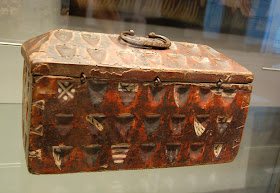The Museum fur angewandte Kunst in Cologne, Germany has a large collection of small medieval caskets, often called 'Minnekästchen', especially when the decoration has scenes of courtly lovemaking. These caskets were used to hold letters and documents or jewellery.
Below are some images of Minnekastchen taken during our visit to Koln.
Below are some images of Minnekastchen taken during our visit to Koln.

Carved casket made of linden of around 1200. Painted reddish brown fastened with bronze rosette bands. Lock and hasp are missing.
Casket made of oak panels nailed together by iron nails dating of around 1300. Carved linden inlays

This casket dates from the third quarter of the 13th century and is thought to be a bridal gift. The casket is made of oak, with a beech bottom. The carved decoration with figures of dragons, stag and bird hunting scenes, knights, lions, musicians, Bacchus, between foliage is of made of linden and painted in green and red, and remnants of gold. The planks of the casket are nailed together with iron nails, whereas the hinges are made of gilded bronze. Lock-plate and hinge are missing. The inside has a small side box on the left and is painted red.eight 12.8 cm, width 47.4 cm and depth 14.8 cm.


 Small casket made of wood covered with leather and metal straps. The leather is decorated. 14th century.
Small casket made of wood covered with leather and metal straps. The leather is decorated. 14th century.14th century casket made of pear. On the lid of the casket carved scenes of a 'Wild Man'. Highly decorated metal straps and lock.


Casket decorated with geometric patterns. Inlays with wood from fruit trees and softwood. 15th century.
Casket made of wood covered with painted parchment and metal straps and lock, dating from the 14th century.
Italian casket made of walnut dating from the 14th century. The casket is painted with heraldic shields. Construction of the wooden panels is with dovetails..
 Casket made from oak, linden and iron with painted scenery. The casket is standing on iron duck-like feet. The lock is missing. Third quarter 14th century.
Casket made from oak, linden and iron with painted scenery. The casket is standing on iron duck-like feet. The lock is missing. Third quarter 14th century. Oval painted wooden box from Florance, Italy, dating from the 15th century.
Small casket of painted wood and iron, bearing heraldic shields. 15th century.
South German casket from the 15th century made of painted softwood.
Ivory casket, with brass straps and hinges from the 15e century. This type of casket can be found throughout the middle ages. A very similar casket is found in the catalogue (part 2) of the exhibition "Die Zeit der Staufer" and has more information on the construction. This casket dates from the second half of the 12th century and was made in Sicily The ivory (thickness 0.5 cm) is nailed to a (linden) wooden inner box. Straps were of gilded copper which ended in small bird heads. The inside is filled with red damask.The casket stands on iron stylised feet. Originally these were turned feet.
The 12th century ivory casket from the Bayern National Museum, Munchen. Image from the exhibition catalogue "Die Zeit der Staufer".


































This comment has been removed by a blog administrator.
ReplyDeleteSadly the Schnutgen museum does not allow photography, unlike the other historic musea in Koln. The last minnekastchen shown in this post was displayed at the Glanz und Grosse des Mittelalters exhibition. However, it is not in the Schnutgen collection, but in the treasury of the St. Ursula church. The three particular images come from two books (the exhibition catalogue and '100 Schatze mittelalterlicher Kunst'). All other photos were taken by me in the MAK.
DeleteDo you have measurements for any of these boxes?
ReplyDelete